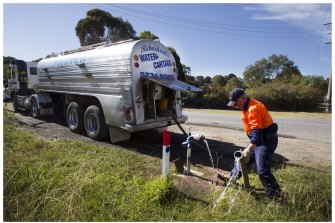The commission found while the initiative’s goal was still “sound”, it had to be modernised to take into account adaptation to climate change, the importance of water to Indigenous Australians, better water planning, increased measurement of water diversions and stronger government oversight.
Loading
Governance had been “significantly eroded” over recent years with the responsible ministerial council disbanded, the National Water Commission closed and states no longer prepared to put in place ongoing plans to reform water services.
This had come despite the growing awareness that both climate change and population growth would put tremendous strains on the nation’s water system.
“This will likely mean material reductions in water availability for most of the country and an increase in the frequency and severity of droughts and floods across the nation. And it will accelerate change in irrigated agricultural production,” it found.
“The droughts and water scarcity experienced during the past 20 years are likely to be a harbinger of things to come. The reality is that Australians will need to become even more adept at dealing with drought, and communities, industries and the environment will have to adapt to lower water availability and more uncertainty.”
The drought leading into the Black Summer prompted promises from all levels of government to secure water supplies, the Morrison government in 2019 created the National Water Grid authority and pledged $3.5 billion in funding for new water infrastructure projects.

A string of regional centres was forced to truck in water during the Black Summer drought. The Productivity Commission says this should be a wake-up call for water policy.Credit:Simon O’Dwyer
But the commission said the grid’s remit should be changed to ditch its focus on supplying water to the farm sector, arguing the new authority was effectively becoming a subsidy for farmers.
“Australian government investment in major water infrastructure should neither prioritise a particular sector or class of water user, nor be limited to providing water for primary industry,” it found.
“Funding major water infrastructure for the benefit of primary industries would amount to subsidising a commercial operation.”
Loading
The commission said the grid should look at funding access for essential town water and also proposed projects worth more than $100 million be reviewed by Infrastructure Australia. The threshold for project review is currently $250 million.
The PC noted what it described as the “flawed” planning process for the Dungowan Dam near the northern inland NSW city of Tamworth. The project, initially priced at $150 million, is now slated to cost the federal and NSW governments $484 million for water the commission estimates is worth just $10 million a year.
While households had slashed their water consumption since the millennium drought, the commission found capital city residents would face growing pressure on water supplies.
It found new sources of water, including stormwater and so-called “recycled” water, should be brought into the general water supply debate. Local council bans on recycled water should end.
Better pricing of water would then enable governments to make more informed decisions on new sources, whether to introduce water use restrictions or build infrastructure such as desalination plants.
Loading
The report called for the removal of exemptions granted to the minerals and onshore gas industries from water regulations that govern consumptive uses and argued increased development in the past few decades had highlighted the difference in rules applied to farmers and miners.
Australia signed the United Nations Declaration on the Rights of Indigenous People in 2009, which states Indigenous Peoples have the right to water resources they traditionally owned. The commission said federal and state regulations should be reformed to deliver more water rights to Indigenous Nations, which barely own any entitlements, for cultural environmental and economic uses.
A study from Griffith University found Aboriginal people comprise 9.3 per cent of the population in NSW’s Murray Darling Basin, but only hold rights to 0.1 per cent of the value of the water market.
Shane is a senior economics correspondent for The Age and The Sydney Morning Herald.
Mike is the climate and energy correspondent for The Age and The Sydney Morning Herald.
Most Viewed in Politics
Loading






